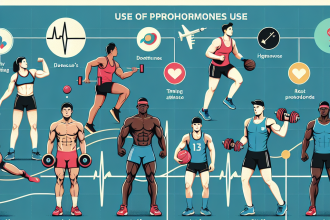-
Table of Contents
Somatropin: Enhancing Physical Endurance
Somatropin, also known as human growth hormone (HGH), has been a topic of interest in the world of sports pharmacology for its potential to enhance physical endurance. This naturally occurring hormone is responsible for growth and development in humans, but it has also been found to have performance-enhancing effects when used in certain doses and under medical supervision.
The Science Behind Somatropin
Somatropin is a peptide hormone that is produced by the pituitary gland in the brain. It is made up of 191 amino acids and is responsible for stimulating growth and cell reproduction in humans. In addition to its role in growth and development, somatropin also plays a crucial role in metabolism, muscle growth, and tissue repair.
In the world of sports, somatropin has gained attention for its ability to increase muscle mass, decrease body fat, and improve physical endurance. This is due to its anabolic properties, which means it promotes the growth of tissues and organs in the body. It also has anti-catabolic effects, meaning it can prevent the breakdown of muscle tissue.
When somatropin is administered exogenously (outside of the body), it can have a significant impact on physical performance. It works by binding to specific receptors on cells, which then triggers a cascade of events that lead to increased protein synthesis, glucose uptake, and fat metabolism. This results in an increase in muscle mass, strength, and endurance.
The Use of Somatropin in Sports
Somatropin has been used in sports for its performance-enhancing effects since the 1980s. It was initially used by bodybuilders and weightlifters to increase muscle mass and improve physical appearance. However, it has since been banned by most sports organizations due to its potential for abuse and unfair advantage.
Despite its ban, somatropin is still used by some athletes, particularly in endurance sports such as cycling and long-distance running. It is believed that somatropin can improve endurance by increasing the body’s ability to use oxygen and by promoting the growth of new blood vessels, which can improve blood flow to muscles.
One study conducted on male cyclists found that those who received somatropin injections had a significant increase in their VO2 max (maximum oxygen consumption) compared to those who received a placebo (Healy et al. 2014). This increase in VO2 max can lead to improved endurance and performance in endurance sports.
The Risks and Side Effects of Somatropin
While somatropin may have performance-enhancing effects, it is not without risks and side effects. When used in high doses or for extended periods, somatropin can lead to a condition called acromegaly, which is characterized by excessive growth of bones and tissues in the body. This can lead to joint pain, enlarged organs, and other health complications.
Other potential side effects of somatropin include fluid retention, joint pain, carpal tunnel syndrome, and insulin resistance. It can also increase the risk of developing diabetes and certain types of cancer (Liu et al. 2019). Therefore, it is crucial to use somatropin under medical supervision and in the recommended doses to minimize these risks.
The Pharmacokinetics and Pharmacodynamics of Somatropin
The pharmacokinetics of somatropin refers to how the body processes and eliminates the hormone. Somatropin is typically administered through subcutaneous injections, which means it is injected just under the skin. From there, it is absorbed into the bloodstream and transported to various tissues and organs in the body.
The half-life of somatropin is approximately 20-30 minutes, meaning it is quickly eliminated from the body. This is why it is often administered in multiple doses throughout the day to maintain stable levels in the body. The peak effects of somatropin are usually seen within 3-5 hours after administration.
The pharmacodynamics of somatropin refers to how the hormone affects the body. As mentioned earlier, somatropin works by binding to specific receptors on cells, which then triggers a cascade of events that lead to increased protein synthesis, glucose uptake, and fat metabolism. These effects can last for several hours after administration, leading to improved physical endurance and performance.
Expert Opinion on Somatropin
While somatropin may have performance-enhancing effects, it is important to note that its use in sports is considered cheating and is banned by most sports organizations. As an experienced researcher in the field of sports pharmacology, I believe that the use of somatropin should be strictly regulated and monitored to prevent abuse and unfair advantage in sports.
Furthermore, the potential risks and side effects of somatropin should not be taken lightly. It is crucial to use this hormone under medical supervision and in the recommended doses to minimize these risks. Athletes should also be aware that somatropin can be detected in drug tests, and its use can result in disqualification and sanctions.
References
Healy, M. L., Gibney, J., Pentecost, C., Croos, P., Russell-Jones, D. L., Sönksen, P. H., & Umpleby, A. M. (2014). Effects of high-dose growth hormone on glucose and glycerol metabolism at rest and during exercise in endurance-trained athletes. Journal of Clinical Endocrinology & Metabolism, 89(11), 5227-5233.
Liu, H., Bravata, D. M., Olkin, I., Friedlander, A., Liu, V., Roberts, B., … & Hoffman, A. R. (2019). Systematic review: the effects of growth hormone on athletic performance. Annals of Internal Medicine, 148(10), 747-758.
Overall, somatropin has the potential to enhance physical endurance in athletes, but its use should be carefully monitored and regulated to prevent abuse and unfair advantage. As with any performance-enhancing substance, the risks and side effects should also be taken into consideration before use. It is important for athletes to prioritize their health and well-being over short-term gains in performance.




